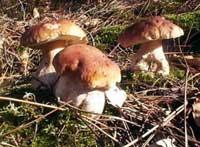The era of hunters is not over
2004/12/01 Galarraga Aiestaran, Ana - Elhuyar Zientzia Iturria: Elhuyar aldizkaria
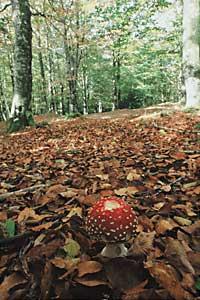
Timber harvesting is the most important forest production, as it is the most economically important. From this point of view, hunting is not so important, but if you look at its social impact, hunting is one of the most outstanding activities that take place in the forest and is deeply rooted in Euskal Herria.
Previously, hunting was one of the sources of proteins of animal origin and, incidentally, an effective way to limit the number of wild animals, since otherwise they caused great damage in rural areas. Now there is no lack of meat and there are other ways to protect fields and livestock. However, hunting activity has not lost strength. In Navarre, for example, there are 32,000 hunters. This means that almost 10% of the population between 18 and 65 years old have hunting permits and this percentage is even higher in rural areas.
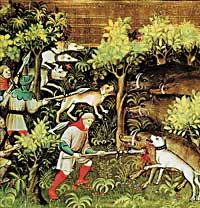
In the ACBC, fewer permits have been granted in recent years. This decline is due to high hunting pressure and scarcity of hunting. However, the Basque Country is one of the European territories with the highest number of hunters per hectare. Because fewer permits are granted from those required, many hunters have to travel to other territories to obtain permission.
Big game, whim of hunters
Most animals hunted in the woods are large. In the enclosed forests, boar is the owner and, in addition, its property is consolidating lately. Many peasants complain about the damage and, in order to control the population, more and more wild boar is being hunted. For example, in the 1980s, about 400 wild boars were hunted in the Basque Country a year, reaching 2,000 specimens today. Many others are hunted in the north and almost double in Navarre.
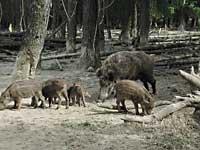
Another example of big game is the deer. This species has also increased considerably in recent times due to the absence of predators that have allowed it to reproduce. But when there are too many deer, the forest has no place for everyone, so some animals starve. In these cases, as in the Gorbeia Natural Park, the most vulnerable or sick animals are slaughtered to decrease their density. Elsewhere, hunters help limit the number of animals.
In the north, in 1978 the deer and roe deer hunting plan was carried out. The objective of this plan is to control the populations of these two species. It hunts 80 deer and 2,000 roe deer a year, although the number of roe deer increases by 30% year after year. In the South, lately the roe deer continues to grow and more permits are being given than before to hunt.
Better one in hand, flying than thousands
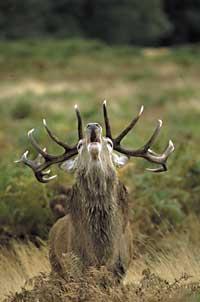
Birds and, in general, minor hunting is not normally hunted in the forest, but in open areas without trees and in cultivated land. Partridge, hare, rabbit and quail are hunted around the fields.
On the other hand, regarding the hunting of migratory birds, Euskal Herria is a good place, since the birds cross the Pyrenees in their path, where hunters meet the shotguns ready to shoot. But it is not a forestry activity either. Although there may be forests on the mountain tops, trees bother more than benefits, in which case hunting stalls are made to the height.
However, few species are hunted in the forest. One of them is the scholarship. During migration, the calf rests in the forests. The vegetation of the forests gives shelter and food, and is sometimes forced to relatively long stays, for example when the weather is very bad. Then hunters can hunt more easily than normal, so limits are placed on hunters. If not, hunt with the heifer raised, both in autumn and winter.
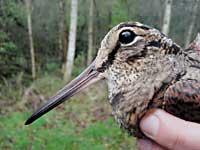
Other species can be hunted in the forest, but the most interesting for hunters are those of gastronomic or symbolic value. No one cares about others. For example, although licenses are sometimes offered for the sacrifice of the corvids, hunters are not interested. Therefore, there are those who think that the defenders of hunting only say half the truth when they say that hunting helps maintain the balance between the species.
It is true that it is convenient that the forest is in good condition to be hunted, and that from this point of view the hunting activity is beneficial for the forest. But it is also true that the hunter deals only with the species that interest him.
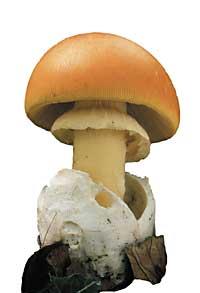
Regardless of the debate, hunting activity can be interesting to complement income in rural areas. Kuartango's hunting ground, for example, has become an important complement to agriculture and elsewhere it is being studied how to obtain greater economic performance from hunting.
Mushrooms: from forest to plate
Compared to hunting, the economic weight of mushroom collection is lower. However, leisure activity is important in Euskal Herria. The collection is mainly for personal consumption or sale in fairs, so it is not easy to know how much is collected and how much is destined to this activity. However, it seems that more and more fans come to the forests to mushrooms and, in addition, some take a nice economic performance from the sale.
There are numerous species that are collected for consumption purposes, but the most important economically are the black fungi Boletus aereus and Boletus pinicola and the white fungus Boletus edulis. They grow mainly in beech and oak trees and concentrate in autumn. The number of fungi varies year after year and experts do not know very well the causative agents, although all recognize that time is very related. Boletus mushrooms are sold expensive at fairs, so it is collected enough for your personal consumption.
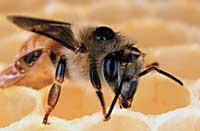
Another well sold is the Lactarius deliciosus esnegorri. Breeding in pine forests, both natural and planted. It also enjoys great prestige outside Euskal Herria, as is the case of Catalonia, and lately they are creating commercial networks.
As the cream is specific to coniferous forests, Russula sp. blue livers form symbiosis especially with leafy trees. The spring mushroom Calobyce gambosa, meanwhile, grows in meadows, in very specific places, so the mushrooms keep it in secret where it is, so that no one takes it. It should be noted that at fairs it is sold expensive.

Many other species are also collected, both for consumption and sale, and some have started planting trees with fungi, as in the case of truffle. This shows that when some forest fruit acquires economic value, the human being tends to cultivate it, since it controls it more easily than if it is left in the wild and takes more economic performance. The clearest example is mushrooms.
Fruits and honey, a delicious gift from the forest
As with the mushrooms it is produced with some fruits of the forest: raspberries, blueberries, strawberries, blackberries, endrinas, garangorras, plums... There are many people who gather to eat at home, but when there is intention to market it the most common is to make plantations. The same goes for medicinal plants.
Within nuts, chestnut harvesting and marketing was of great importance in the past. However, chestnuts are now quite abandoned because chestnut trees have suffered disease, and because life has changed from the rural to the industrial world. Many of the traditional varieties are lost and those sold are quite mixed. Although they are still sold at the fairs, there are more and more imports from Galicia.
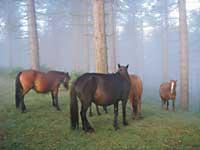
Indirectly, another fruit produced by forests is honey. Honey has also lost strength with the change of life, but there are still hives near the woods. Only in Navarre, for example, there are some 7,000 hives, mostly in the mountain area, which add up to 120 tons of honey per year. They also provide two tons of wax, but although honey is sold well, the same does not happen with wax, pollen and royal jelly.
Bees are loose in wild and cultivated areas, so beekeepers pay nothing for forest use. Furthermore, since bees also contribute to crop pollination, society in general values honey positively.
Through the forest
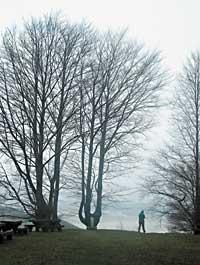
Not only does it take advantage of what comes out of the forest, but it can also be a way to take advantage of it. There is nothing more to see the fate of the forest in summer. In addition to food, cattle get shade, moisture and freshness in the forest: sheep, mares, pigs, cows... all appreciate the protection and shade of the forest.
Although nowadays there are not many animals that circulate in the forests, in some cases they cause damage. Goats are especially poorly seen, as they eat young trees and shoots, so if they are too much in one place, they can cause deforestation. Something similar happens with the excessive accumulation of cows or sheep, but in general they do not exert the necessary pressure to cause damage in the forest.
Another species that only enjoys entering the forest is man. It is difficult to walk through the forest without leaving a trace, but it is an indispensable condition for the following to enjoy as well. Although it seems obvious, this requirement is not met enough, and mountaineering and other recreational uses cause significant damage to the forest: garbage everywhere, access to the forest flooded with cars, noise, erosion of roads and slopes...
However, access to the forest in free time also has positive aspects. The more people learn to love the forest, the more they will be willing to protect and care for it.
Forests as a source of energy?
Before, small trunks, branches, tree barks, etc. were used for fire. This material was collected by the villages of the forest area for the home and some also worked on the sale of this wood. This activity is maintained in many places and has great influence in the forest, since sick and bad trees are removed.
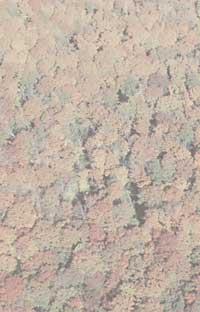
Apart from what is collected for fire, the human being takes very little advantage of this forest resource. Sometimes it is collected to make compost and gardening, but it is usually deposited in the forest itself for the benefit of fungi and many living beings. By not providing money directly, estimates have been made to know the value of use as fuel. Thus, the Government of Navarra has estimated that burning the wood that leaves rot in the forests would represent 8% of the energy needed for Navarran households. They consider this possibility to be underutilized.
In any case, the use of scrubs, etc. to obtain energy carries risks. In fact, now the whole scrub can become a future in a forest, and if everything burns away the possibility of recovering it.
Risks of mushroom collection
It seems that mushroom collection has become fashionable. More and more people come to the forest to mushrooms and that can be dangerous. According to the Department of Mycology of the Arkamurka Group, the greater the number of people, the greater the risk of mistreating mushrooms and therefore damaging them. Therefore, in some areas mushrooms are being lost.
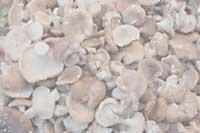
However, Arkamurka considers that the loss of mushrooms is due to other factors. In recent years it has been observed that on the coast there are fewer mushrooms than before; this loss has been detected in both quantity and variety of species, and it is not because people have collected them too or badly. In this case, climate change and pollution are suspected to have some influence.
In any case, it seems necessary to carry out research to know what the situation is, since otherwise you can not know if any is in danger of extinction or not. In addition, they consider that you have to control how, where, how many species are collected mushrooms, so they are in favor of establishing a collection regulation.
Keep in mind that mushrooms, even if they are everywhere, grow mostly in deciduous forests, even if they are closed. These forests are humid and have a relatively constant temperature. In addition, in the undergrowth accumulates abundant organic matter, which is what most mushrooms need to feed and grow. By the way, mushrooms mineralize organic matter. Therefore, they are essential to complete the food cycle.

Gai honi buruzko eduki gehiago
Elhuyarrek garatutako teknologia





